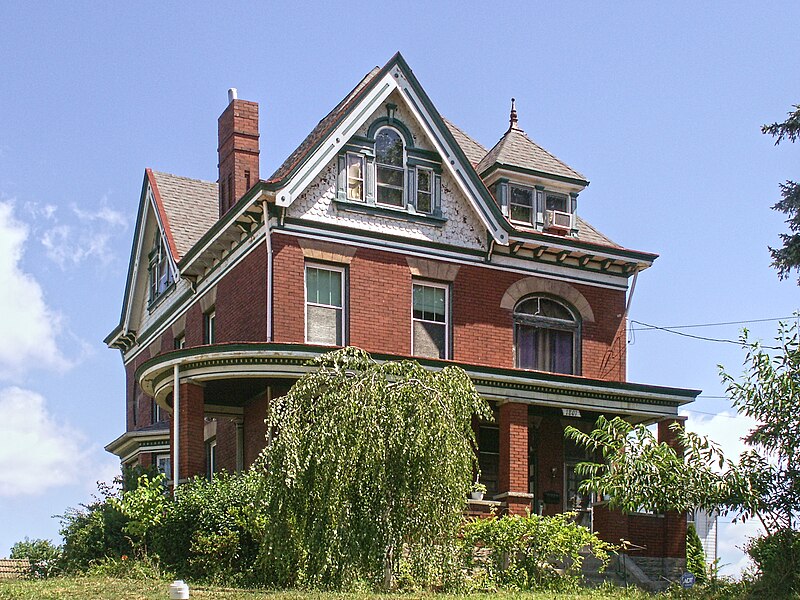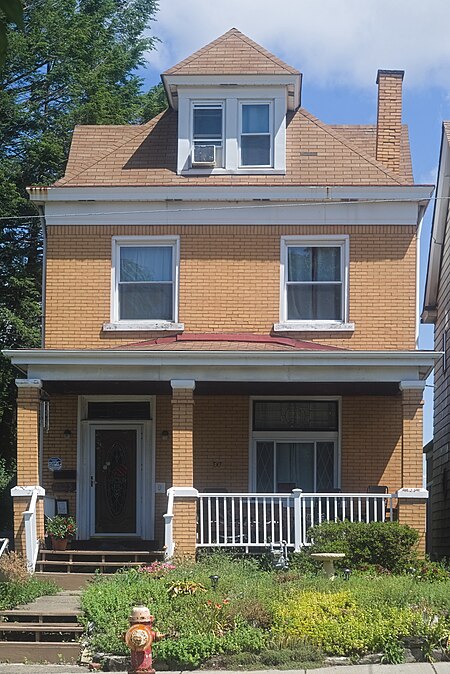
This little Romanesque church on Arlington Avenue was converted to residential use with almost no alteration of the exterior.




This little Romanesque church on Arlington Avenue was converted to residential use with almost no alteration of the exterior.




St. Henry Church has been abandoned for years, and it is slowly rotting away. Yet the neighborhood still remembers it as a point of pride: when Father Pitt was taking pictures along Arlington Avenue the other day, some locals stopped to talk and immediately asked, “Did you see our church?”

And, of course, our utility cables.
St. Henry was designed by Marlier & Johnstone and built in 1952, when the neighborhood was thriving.

Each of those squares had a symbolic relief at its center, with a big metal cross in the middle of the façade. Those have all been taken away, because when Catholics abandon a building, they generally preserve whatever is unique and valuable about it and place it in another parish if possible. It does leave the building looking stripped, but we can understand the impulse.

The entrance is sharply drawn in a style that flavors modern with just a bit of late Art Deco.

An abstract cross-topped cupola.

An exhibition of utility cables.

The rectory is older than the church; it is hard to guess the age of it, and it has been added to in various eras and various styles.





The school next to the church has been abandoned twice. It was a public primary school for a while after the parochial school closed, but the public school closed a few years ago.

Arlington Avenue is the business spine of the Arlington neighborhood, although not much business is left. Still, things are picking up, and there are more businesses now than there were a couple of years ago. The buildings on the street share certain similarities in style, but the thing a visitor will notice first is that very few of them are rectangles. Most of them are parallelograms or trapezoids. In these pictures, when you see buildings where the walls do not seem to meet at right angles, that is not because of distorted perspective from a wide-angle or telephoto lens. It is because the walls do not meet at right angles, as we see in this building, with an acute angle on the corner. Note also the cheaper red brick on the side wall, with the expensive Kittanning brick used only on the front.

Arlington Avenue is also a gourmet feast for lovers of utility cables.




The building above is the only one of the storefronts for which old Pa Pitt has an architect’s name: Edward Goldbach, who lived just down the hill from the building. It is quite possible that we will eventually find Mr. Goldbach’s name attached to several other buildings on the street: many of them share similar design principles and a similar taste for yellow Kittanning brick.





The little frame store at left is yet another skewed parallelogram.

These buildings are all skewed.




This Second Empire building was actually rectangular, but the modern storefront addition filled out the lot and made an acute angle.

These cellular masts probably make a large contribution to the economy of the Arlington Avenue business district. And here is our most artistic arrangement of utility cables yet.


This Second Empire building, on the other hand, took full advantage of the whole lot, leaving it with an obtuse angle at the corner.


These buildings are skewed in different ways, just to make sure the streetscape is never boring.


Very few service stations from the early years of the automobile have survived in Pittsburgh, even though Pittsburgh invented the drive-up filling station. This one is a good representative of the class, and though it no longer sells gasoline it remains in the automobile business today.


This odd little building in the middle of a gravel lot is a remnant of the largest streetcar system in the United States.

We’ve already seen this picture of Arlington Avenue with the Route 48 streetcar poking its head out of the streetcar loop. That loop is still there, though the tracks have been taken up. You can see this little shelter right behind the trolley in the 1968 picture.
In the 1960s. Pittsburgh had the largest remaining streetcar system in the country. We had lagged behind other cities in converting to bus transit, but the Port Authority, newly responsible for the transit system, was canceling streetcar lines right and left. (Some lines have survived—the lines that had their own right-of-way for most of the route, and thus would have been expensive or impossible to convert to buses.) The Arlington line would not survive long after that picture; the Route 48 streetcar became the Route 48 bus.

Here the Route 48 bus passes a mural with a picture of its predecessor, the Route 48 streetcar. The “Arlington Memories” murals are fading and will soon be memories themselves. The Route 48 streetcar line used to make a loop around the shelter and head back inbound on Arlington Avenue.






Arlington Avenue was already looking a bit bedraggled in 1968, when David Wilson, a streetcar fanatic who documented the streetcar lines of Pittsburgh with hundreds of pictures, caught the Route 48 car peeking out of the streetcar loop.
Most of the buildings in this picture are still there on Arlington Avenue, but the Arlington business district has mostly been abandoned by business. The storefronts that are not empty have been filled in for apartments.


This one, with a much-altered ground floor, is still going as a convenience store. Because the street plan in Arlington is irregular, many of the commercial buildings on Arlington Avenue are odd shapes.


This little storefront has been filled in by a contractor who had no need of a busybody architect to tell him what to do. The original building is a pleasing little composition by someone who might have seen some of the German art magazines that circulated among architects in Pittsburgh.

A little of the Kittanning brick facing has come down from the front of this building, revealing the cheaper ordinary brick behind it.









Now, about that streetcar loop: we’ll be seeing that very soon, because it is still there as well, or at least partly so.

Arlington is a forgotten neighborhood whose business district has almost disappeared, but it nevertheless has many pleasant residences on its back streets. The spine street, however, was Arlington Avenue, and because it was the main street of the neighborhood, it was where the grandest houses went up. Some of these houses are in very good shape; some are abandoned and being eaten by jungle; and some are in between. The house above is in good shape except for wanting a bit of paint, and its original woodwork is intact.

The round-ended porch is a work of art that ought to be preserved. Father Pitt wonders whether it always had brick pillars, or whether it was originally supported by wooden columns to match the pilasters in the rear. At any rate, the brick pillars are old enough that they match the house brick exactly.


This frame house could also use a bit of paint, but much of its woodwork is well preserved.




This double house is in excellent shape, and almost completely original except for the asphalt shingles on the roof.

Next to that tidy double is a house that probably cannot be rescued. It has been neglected for so long that it never even had a chance to be shrouded in aluminum siding, so its original woodwork, crumbling though it may be, is still there for us to document.





And finally, next to that abandoned house, this neat and well-kept Pittsburgh Foursquare.
We should note that city planning maps make Arlington Avenue the border between Arlington and the South Side Slopes. This is one of those cases where the city’s dogmatic insistence on main streets as neighborhood borders leads to obvious absurdity: it means that the Arlington Playground, Arlington Field, Arlington Spray Park, Arlington Recreation Center, Arlington Baseball Field, and so forth, are not in Arlington. In this case, old Pa Pitt ignores the city’s boundaries and speaks of “Arlington” the way Pittsburghers have always meant it.
Cameras: Konica Minolta DiMAGE Z6; Sony Alpha 3000 with Industar f/3.5 50mm lens.

This tiny church is marked “PRES. CH.” on our 1923 map, but no other name is given. It now belongs to the Congregation of Yahshua, which keeps it in good shape. Old Pa Pitt is especially taken with the bright purple paint, which sets apart what is otherwise a tasteful but ordinary little Gothic church. Like many churches in Pittsburgh, it has its social hall and so forth in a basement that is also a ground floor depending on where you enter it.
